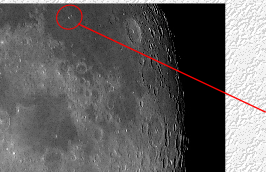First light with my Orion Optics GX200 (FL=1250mm) Reflector on a Vixen GP equatorial mount and an ordinary USB WebCam.
I used an unmodified ToUcam Pro webcam with a “Chris Heapy” made EP adapter, a Baader IR filter and an ordinary Moon Filter. The ToUcam was used at prime focus, giving me a FOV similar to what I see with a 10mm EP. I manually guided and focused the scope and captured images on a laptop using AstroSnap v1.4.
Processed frame - JPG compressed.
Unsharp mask, Brightness/Contrast fix, Grey-scaled.
Untouched frame - JPG compressed.
Processed frame - JPG compressed.
Unsharp mask, Brightness/Contrast fix, Grey-scaled.
I was also pleased with this shot of Lagrenus. Again this is a single frame. Additionally, I can clearly see the impact craters Messier and Messier A, along with their associated rays.
Despite the fact that my ToUcam Pro is not long exposure (LX) modified, I thought I would try to image some of my favourite double stars. I was amazed that I was able to split them, and even capture some colour - just look at Albireo! Even Eta Casseopia looks like it has colour.
The 08/09/06 Imaging Session Gallery Images were all captured using my Orion Optics GX200 with an unmodified ToUcam Pro webcam and a Baader IR blocking filter at prime focus. I used AstroSnap v1.4 to capture the images. Post capture processing was done using Serif PhotoPlus 10.
Mare Crisium is a lava-filled basin on the eastern edge of the moon containing 3 notable craters within it. The largest crater is called “Picard”, followed by “Peirce” and “Swift”.
My prize shot was easily this single frame of Mare Crisium - The Sea of Crisis. Shown here before and after processing







